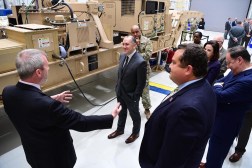JADC2: All new architecture, same technology, says Air Force software chief

The Air Force‘s effort to connect the military across all domains will require a complex new data architecture — but largely it shouldn’t require a transformation of the underlying technology, the department’s top software official told FedScoop.
“It is all the same” technology, Nicolas Chaillan, chief software officer of the Air Force, told FedScoop on Tuesday after speaking at a MicroFocus event. “Obviously the mission is crazy complex.”
The military’s push for global data interoperability is called Joint All-Domain Command and Control, or JADC2. This network-of-networks is the latest buzzword in the Department of Defense’s preparation for the future of warfare — one in which everything is connected. For instance, top generals envision sensor data from small drones in the sky being read by submarines deep under the ocean’s surface, and all of that is fed back to the Pentagon in real-time to better inform command and control. The mission is guided by the goal of connecting “every sensor, every shooter,” as the Secretary of the Air Force Barbara Barrett told Congress recently.
While Chaillan said this won’t require a major technology transformation, what will be “completely new” is the open-source data architecture, and how security and data analysis are automated. That new architecture will be built with the same Kubernetes and containers that the Air Force is using to develop software today.
The stacks and data architecture developed with the Kubernetes open-source orchestration system will also be built with automated security baked-in, Chaillan said. He used Space X, Elon Musk’s rocket launch company, as an example the Air Force can look for how to use automation. The company only has 50 people writing code across nine vehicles — a small human footprint enabled by automated security that constantly scans for anomalies and potential breaking points, he said. The Air Force, on the other hand, has 4,000 people working on the code just for the F-35 fighter jet.
“We are also trying to streamline the process and remove manual testing where we can,” Chaillan said of all of the Air Force’s software development teams.
The Air Force is leading the charge on this new data structure and recently requested more than $300 million to develop JADC2 from its in-testing data management system, the Advanced Battle Management System (ABMS).






